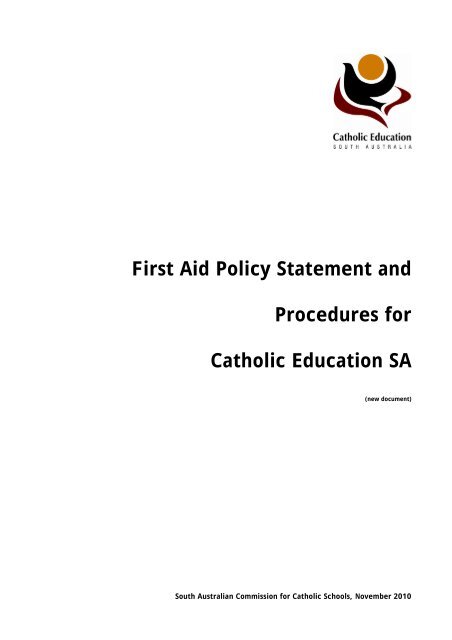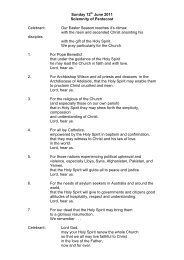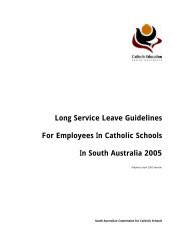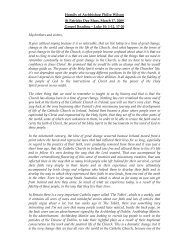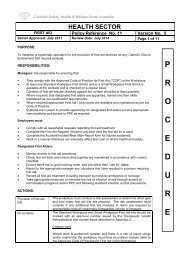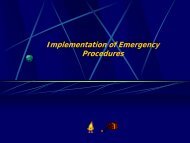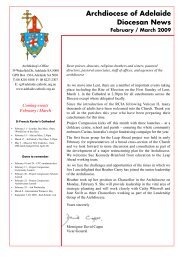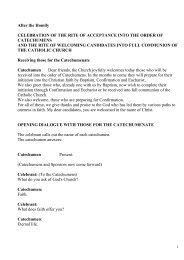First Aid Policy Statement and Procedures for Catholic Education SA
First Aid Policy Statement and Procedures for Catholic Education SA
First Aid Policy Statement and Procedures for Catholic Education SA
You also want an ePaper? Increase the reach of your titles
YUMPU automatically turns print PDFs into web optimized ePapers that Google loves.
<strong>First</strong> <strong>Aid</strong> <strong>Policy</strong> <strong>Statement</strong> <strong>and</strong><br />
<strong>Procedures</strong> <strong>for</strong><br />
<strong>Catholic</strong> <strong>Education</strong> <strong>SA</strong><br />
(new document)<br />
South Australian Commission <strong>for</strong> <strong>Catholic</strong> Schools, November 2010
CONTENTS<br />
1. INTRODUCTION ................................................................................. 1<br />
2. PURPOSE ................................................................................... 1<br />
3. POLICY STATEMENT ........................................................................... 1<br />
4. TRAINING AND QUALIFICATIONS ............................................................. 1<br />
5. DUTIES OF PRINCIPAL/LINE MANAGER ...................................................... 2<br />
6. DUTIES OF EMPLOYEES ........................................................................ 3<br />
7. ADMINISTRATION OF MEDICATION .......................................................... 3<br />
8. RECORDS MANAGEMENT ...................................................................... 4<br />
9. REFERENCES ................................................................................... 4
1. INTRODUCTION<br />
<strong>First</strong> aid is the immediate care given to an ill or injured person until more<br />
advanced care arrives or the person recovers. In an emergency situation first aid<br />
aims to maintain life, prevent further harm or injury, ease pain <strong>and</strong> avert<br />
deterioration of the person's condition until professional medical help can be<br />
obtained.<br />
This policy statement <strong>and</strong> procedures apply to all staff (employees), students,<br />
volunteers <strong>and</strong> others working with students in <strong>Catholic</strong> schools in South Australia<br />
These procedures should be read in conjunction with the <strong>First</strong> <strong>Aid</strong> <strong>Policy</strong> <strong>and</strong><br />
Procedure, <strong>Catholic</strong> Safety Health <strong>and</strong> Welfare <strong>SA</strong> Document No. 11, the<br />
references listed at the end of this document <strong>and</strong> the school’s own relevant<br />
policies <strong>and</strong> procedures.<br />
2. PURPOSE<br />
To guide principals <strong>and</strong> line managers in the achievement of legislative<br />
compliance, duty of care <strong>and</strong> the development of consistent practice in the<br />
planning, delivery <strong>and</strong> administration of appropriate first aid in the case of<br />
illness or injury.<br />
3. POLICY STATEMENT<br />
The duty of care owed by education <strong>and</strong> childcare personnel is that of a<br />
"reasonable professional". Care providers, teachers <strong>and</strong> support workers have a<br />
special <strong>and</strong> primary duty to the children <strong>and</strong> students in their care.<br />
All staff must be trained <strong>and</strong> prepared to provide at least basic first aid while<br />
awaiting more expert assistance.<br />
Other personnel (students, volunteers, <strong>and</strong> others working with students)<br />
must have appropriate first aid training where a risk assessment indicates that it<br />
is an appropriate control.<br />
4. TRAINING AND QUALIFICATIONS<br />
In South Australia, the basic first aid procedures required by all staff are taught<br />
in the Basic Emergency Life Support (BELS) course or equivalent. All schools must<br />
have at least one nominated/designated senior first aid officer (hereafter<br />
referred to as Designated Senior <strong>First</strong> <strong>Aid</strong> Officer) <strong>and</strong> it is recommended that<br />
schools refer to the table attached to this document as Appendix A in<br />
determining the appropriate number of such officers. A designated first aid<br />
officer is an employee who holds a current recognised first aid certificate (Senior<br />
<strong>First</strong> <strong>Aid</strong> Certificate) or equivalent qualification <strong>and</strong> is designated as the person<br />
required by the employer to per<strong>for</strong>m first aid duties. Personnel who hold these<br />
positions <strong>and</strong> who are <strong>Education</strong> Support Officers may be paid a first aid<br />
allowance (See: School Assistants (Non-Government Schools) Award, Schedule 1,<br />
clause S1.6).<br />
<strong>First</strong> <strong>Aid</strong> Polic y Sta tement a nd Proc ed ures <strong>for</strong> Ca tholic Ed uc a tion <strong>SA</strong><br />
Page 1
5. DUTIES OF PRINCIPAL/LINE MANAGER<br />
The principal/line manager must ensure that a system is in place <strong>for</strong> the<br />
provision of first aid <strong>for</strong> the school community.<br />
5.1 The principal/line manager should consider such factors as:<br />
5.1.1 identification, assessment <strong>and</strong> control of hazards <strong>and</strong> risk<br />
associated with individual needs <strong>and</strong> the work conducted at the<br />
site<br />
5.1.2 the site’s capacity <strong>for</strong> early reporting, intervention <strong>and</strong> treatment<br />
to minimise the severity of illness or injury<br />
5.1.3 number of employees <strong>and</strong> students at the workplace who may<br />
require first aid<br />
5.1.4 availability of the designated senior first aid officers to assist ill or<br />
injured persons during normal working hours <strong>and</strong> where necessary,<br />
after hours<br />
5.1.5 accessibility to the designated first aid officer<br />
5.1.6 the impact of sporting activities, excursions, camps, illness, injury<br />
or other factors on the provision of first aid<br />
5.1.7 the training needs of employees<br />
5.1.8 voluntary disclosure by employees, parents <strong>and</strong> students of<br />
predictable first aid risks <strong>and</strong> health care needs, which may<br />
require additional duties from others at the worksite on a need to<br />
know basis; <strong>for</strong> example, seizures, epilepsy, asthma, fainting,<br />
allergies<br />
5.1.9 planning to manage first aid risk<br />
5.1.10 developing an appropriate care plan <strong>for</strong> all medications to be<br />
administered at school (see Section 7: Administration of<br />
Medication)<br />
5.1.11 local procedures related to the actual provision of first aid at the<br />
site<br />
5.1.12 provision <strong>and</strong> maintenance of first aid facilities, in<strong>for</strong>mation <strong>and</strong><br />
equipment; in accordance with <strong>First</strong> <strong>Aid</strong> <strong>Policy</strong> <strong>Statement</strong> <strong>and</strong><br />
<strong>Procedures</strong> <strong>for</strong> <strong>Catholic</strong> <strong>Education</strong> <strong>SA</strong>, <strong>for</strong> example:<br />
• first-aid kits in appropriate locations, with appropriate signage<br />
• in<strong>for</strong>mation about the system to all employees, students,<br />
visitors, volunteers <strong>and</strong> contractors during induction <strong>and</strong> other<br />
times as required<br />
• a first aid room, a rest area or similar.<br />
5.1.13 contingency plans <strong>for</strong> personnel who are working outside of<br />
normal hours<br />
5.1.14 the use of st<strong>and</strong>ard precautions to prevent transmission of<br />
infection due to exposure to blood, body fluids <strong>and</strong> the<br />
environment<br />
<strong>First</strong> <strong>Aid</strong> Polic y Sta tement a nd Proc ed ures <strong>for</strong> Ca tholic Ed uc a tion <strong>SA</strong><br />
Page 2
5.1.15 notification of an injury, incident or illness where necessary<br />
5.1.16 arrangements <strong>for</strong> treating <strong>and</strong> transporting an injured person or<br />
student to expert help, <strong>for</strong> example, doctor or hospital<br />
5.1.17 including the provision of first aid as part of the Position<br />
In<strong>for</strong>mation Document when advertising <strong>for</strong> any employee.<br />
6. DUTIES OF STAFF, STUDENTS, VOLUNTEERS AND<br />
OTHERS WORKING WITH STUDENTS<br />
All personnel within the scope of this policy must:<br />
• undertake training in accordance with the level of risk, <strong>SA</strong>CCS policy <strong>and</strong> the<br />
requirements of the Occupational Health Safety <strong>and</strong> Welfare Regulations<br />
1995, Division 2.11, Occupational Health <strong>and</strong> <strong>First</strong> <strong>Aid</strong> in the Workplace<br />
• practise st<strong>and</strong>ard precautions<br />
• become familiar with local first aid procedures<br />
• render first aid in accordance with training as required<br />
• administer medications as agreed through the care plan<br />
• record details of any treatment as required<br />
• report first aid treatment to school leadership or delegated authority<br />
• report first aid risks.<br />
7. ADMINISTRATION OF MEDICATION<br />
Administration of prescribed medications is one part of the overall provision of<br />
first aid by schools. In accordance with duty of care obligations, occupational<br />
health <strong>and</strong> safety requirements <strong>and</strong> non-discriminatory practice, schools have<br />
the responsibility <strong>for</strong> ensuring that arrangements are in place <strong>for</strong> the<br />
administration of medication.<br />
Medication should only be administered in line with the training of staff. In<br />
addition, medication should not be administered at school if it can be<br />
administered outside of school hours without compromising the wellbeing of the<br />
child. An appropriate care plan should be developed (see Health Support<br />
Planning in schools, preschools <strong>and</strong> childcare services DETE) <strong>for</strong> all medication to<br />
be administered at school with consultation between the doctor, the family <strong>and</strong><br />
the school to ensure reasonable, fair <strong>and</strong> safe access to assistance as determined<br />
by schools <strong>and</strong> when needed in relation to students with a known or predictable<br />
first aid need.<br />
School principals are ultimately responsible <strong>for</strong> ensuring that arrangements <strong>and</strong><br />
procedures are in place <strong>for</strong> the administration of medication <strong>and</strong> it is there<strong>for</strong>e a<br />
management decision in determining who will administer the medication. Staff<br />
responsible <strong>for</strong> administering medication or supervising self-medication must be<br />
given guidelines in accordance with any relevant health care <strong>and</strong>/or first aid<br />
plan.<br />
<strong>First</strong> <strong>Aid</strong> Polic y Sta tement a nd Proc ed ures <strong>for</strong> Ca tholic Ed uc a tion <strong>SA</strong><br />
Page 3
It is essential to consider the detailed provisions in the:<br />
• <strong>First</strong> <strong>Aid</strong> in Early Childhood Centres <strong>and</strong> Schools <strong>and</strong><br />
• Health Support Planning in Schools, Preschools <strong>and</strong> Childcare Services<br />
It is also essential <strong>for</strong> schools to maintain a record of the dates <strong>and</strong> times at<br />
which medication is administered, <strong>and</strong> to ensure that relevant medication logs<br />
are completed.<br />
8. RECORDS MANAGEMENT<br />
As a guide, schools should retain all records relating to first aid assistance<br />
provided in accordance with the following:<br />
• Staff records - until the staff member is 75 years of age or seven years<br />
after the last action, whichever is the later.<br />
• Student records - until the student is 25 years of age or seven years after<br />
the last action, whichever is the later. For further detailed in<strong>for</strong>mation<br />
(Refer to the Department of <strong>Education</strong> & Training documents below.<br />
9. REFERENCES<br />
9.1 South Australian Occupational Health <strong>and</strong> Safety Commission—Approved<br />
Code of Practice <strong>for</strong> Occupational Health <strong>and</strong> <strong>First</strong> <strong>Aid</strong> in the Workplace<br />
9.2 Department of <strong>Education</strong> Training <strong>and</strong> Employment: <strong>First</strong> <strong>Aid</strong> in Early<br />
Childhood Centres <strong>and</strong> Schools<br />
9.3 Occupational Health Safety <strong>and</strong> Welfare Act 1986<br />
9.4 Occupational Health Safety <strong>and</strong> Welfare Regulations 1995, Division 2.11<br />
Occupational Health <strong>and</strong> <strong>First</strong> <strong>Aid</strong> in the Workplace <strong>and</strong> scroll down to<br />
current version<br />
9.5 Staff & Student Records (CE<strong>SA</strong> Online)<br />
9.6 <strong>First</strong> <strong>Aid</strong> <strong>Policy</strong> & Procedure, <strong>Catholic</strong> Safety Health <strong>and</strong> Welfare <strong>SA</strong><br />
Document No. 11 V3<br />
9.7 <strong>SA</strong>CCS Duty of Care <strong>Policy</strong><br />
9.8 <strong>SA</strong>CCS <strong>Procedures</strong> <strong>for</strong> Excursions, Camps, Adventure, Physical <strong>and</strong><br />
Sporting Activities<br />
9.9 <strong>Policy</strong> – Infectious or Contagious Diseases “You’ve Got What”?<br />
<strong>First</strong> <strong>Aid</strong> Polic y Sta tement a nd Proc ed ures <strong>for</strong> Ca tholic Ed uc a tion <strong>SA</strong><br />
Page 4
Appendix A<br />
Table 3. Minimum requirements <strong>for</strong> workplaces that are Low Risk <strong>and</strong> Not-Remote<br />
No of<br />
employees<br />
at the<br />
workplace<br />
Less than<br />
10<br />
Minimum number of designated <strong>First</strong><br />
<strong>Aid</strong>ers (DFA) required<br />
Consider at least 1 Basic DFA<br />
Requirements <strong>for</strong> first aid<br />
rooms or occupational<br />
health services<br />
Not applicable (NA)<br />
10 to 50 At least 2 Basic DFA or 1 Senior DFA NA<br />
At least:<br />
51 to 100 • 2 Senior DFA, or<br />
NA<br />
• 1 Senior DFA + 2 Basic DFA; or<br />
• 4 Basic DFA<br />
At least:<br />
• 2 Senior DFA, or<br />
• 1 Senior DFA + 2 Basic DFA; or<br />
100 +<br />
• 4 Basic DFA<br />
And<br />
NA<br />
For every extra 100 employees (or<br />
part thereof) at least:<br />
1 extra Senior DFA or<br />
2 extra Basic DFA<br />
(From: “Approved Code of Practice <strong>for</strong> <strong>First</strong> <strong>Aid</strong> in the Workplace”)<br />
These numbers of personnel may need to be increased, depending on;<br />
a) The size <strong>and</strong> layout of the workplace;<br />
b) the location of the workplace;<br />
c) The number <strong>and</strong> distribution of employees including casual <strong>and</strong> shift work<br />
arrangements;<br />
d) The nature <strong>and</strong> specific hazards of the work;<br />
e) Known occurrences of accidents or illnesses;<br />
f) The distance from the workplace to the nearest available <strong>and</strong> appropriate<br />
occupational health or medical services.<br />
Code Of Practice For Occupational Health And <strong>First</strong> <strong>Aid</strong> In The Workplace,<br />
Occupational Health Safety <strong>and</strong> Welfare Act 1986<br />
A remote workplace is one that is more than a 20 minute drive away from an <strong>SA</strong><br />
Ambulance station that is staffed by paid paramedics.<br />
<strong>First</strong> <strong>Aid</strong> Polic y Sta tement a nd Proc ed ures <strong>for</strong> Ca tholic Ed uc a tion <strong>SA</strong><br />
Page 5
Examples of workplaces that may be considered high risk include (but are not limited<br />
to) those that feature one or more of the following:<br />
a) The use of hazardous plant (e.g. cranes, trucks, <strong>for</strong>klifts, tractors, power<br />
presses, vehicle hoists)<br />
b) The regular use of hazardous <strong>and</strong>/or dangerous substances (e.g. chemical<br />
manufacture, horticulture, petrol stations <strong>and</strong> food manufacturing)<br />
c) The risk of falls of over 2 metres (e.g. construction <strong>and</strong> stevedoring)<br />
d) Hazardous <strong>for</strong>ms of work (e.g. working in confined spaces, welding, demolition<br />
<strong>and</strong> abrasive blasting)<br />
e) Several factors that create a greater than usual risk of physical violence or<br />
armed robbery (e.g. working alone, working at night, cash h<strong>and</strong>ling, when the<br />
design of the workplace offers little or no protection from attack; <strong>and</strong>/or having<br />
clientele who are frequently physically aggressive)<br />
f) Working in or around extreme heat (foundries, glass works, food manufacturing,<br />
commercial kitchens, prolonged outdoor work in extreme temperatures).<br />
<strong>First</strong> <strong>Aid</strong> Polic y Sta tement a nd Proc ed ures <strong>for</strong> Ca tholic Ed uc a tion <strong>SA</strong><br />
Page 6
This Document Will Be Reviewed In November 2015 Or As Regulatory Or Other Associated Matters<br />
Updated November 2010<br />
Review November 2015<br />
For further in<strong>for</strong>mation contact:<br />
Executive Officer<br />
South Australian Commission <strong>for</strong> <strong>Catholic</strong> Schools<br />
PO Box 179 Torrensville Plaza South Australia 5031<br />
Telephone: (08) 8301 6600<br />
Facsimile: (08) 8301 6611<br />
http://www.adelaide.catholic.org.au/


